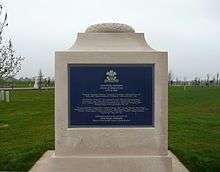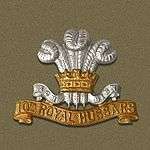10th Royal Hussars
| 10th Royal Hussars (Prince of Wales's Own) | |
|---|---|
|
Badge of the 10th Royal Hussars | |
| Active | 1715–1969 |
| Country |
|
| Branch |
|
| Type | Cavalry |
| Role | Line Cavalry |
| Size | 1 Regiment |
| Nickname(s) | Baker's Light Bobs, The Chainy 10th, The Shiny 10th |
| Motto(s) | Ich Dien (I Serve) |
| March | (Quick) The Merry Month Of May |
| Anniversaries | El Alamein (23 Oct) |
| Commanders | |
| Notable commanders |
John Vaughan Reginald Barnes |
The 10th Royal Hussars (Prince of Wales's Own) was a cavalry regiment of the British Army raised in 1715. It saw service for three centuries including the First World War and Second World War but then amalgamated with the 11th Hussars (Prince Albert's Own) to form the Royal Hussars (Prince of Wales's Own) in October 1969.
Early history

The regiment was raised at Hertford by Brigadier-General Humphrey Gore as Humphrey Gore's Regiment of Dragoons in 1715 as part of the response to the Jacobite rising.[1] The regiment was involved in cavalry charges at both the Battle of Falkirk Muir in January 1746[2] and the Battle of Culloden in April 1746 during the next Jacobite rising.[3] It was retitled as the 10th Regiment of Dragoons in 1751.[1]
The regiment took part in the Raid on St Malo in June 1758 during the Seven Years' War.[4] It also saw action at the Battle of Minden in August 1759,[5] the Battle of Warburg in July 1760[6] and the Battle of Kloster Kampen in October 1760. At Kloster Kampen the regiment's commanding officer, Colonel William Pitt, was badly wounded and taken prisoner.[7] The regiment went on to take part in the Battle of Villinghausen in July 1761.[8] In 1779, the light troop was detached to form the 19th Regiment of (Light) Dragoons, and in 1783 the Dragoons Regiment was retitled as the 10th (Prince of Wales's Own) Regiment of (Light) Dragoons in honour of the future King George IV .[1] In June 1794 Beau Brummell, who became an arbiter of men's fashion in regency London, joined the regiment as a cornet.[9]
Napoleonic Wars
In 1806, the regiment was again re-designated, this time becoming a hussar regiment as the 10th (Prince of Wales's Own) Regiment of (Light) Dragoons (Hussars),[1] and sailed for Corunna in Spain in November 1808.[10] The regiment saw action at the Battle of Sahagún in December 1808[11] and the Battle of Benavente later in December 1808 during the Peninsular War.[12] At Benavente the regiment captured General Charles Lefebvre-Desnouettes, the French cavalry commander.[13]The regiment then took part in the Battle of Corunna in January 1809 before returning to England.[14]
In 1813, having landed once more in Spain, the regiment fought at the Battle of Morales in June 1813.[15] During the battle the regiment destroyed the 16th French Dragoons between Toro and Zamora, taking around 260 prisoners.[16] The regiment also fought at the Battle of Vitoria later in the month while still in Spain[17] and then, having advanced into France, fought at the Battle of Orthez in February 1814[18] and the Battle of Toulouse in April 1814.[19] As part of the 6th Cavalry Brigade, the regiment charged the French cavalry and infantry at the Battle of Waterloo in June 1815.[20]
Victorian era
.jpg)
_Royal_Regiment_of_Hussars.jpg)
The regiment was sent to India in 1846 and then saw action at the Siege of Sevastopol in winter 1854 and at the Battle of Eupatoria in February 1855 during the Crimean War.[13] In 1861, it was renamed the 10th (The Prince of Wales's Own) Royal Hussars.[1] The regiment saw action at the Battle of Ali Masjid in November 1878 during the Second Anglo-Afghan War[21] and at the First and Second Battles of El Teb in February 1884 during the Mahdist War.[22]

With the outbreak of the Second Boer War, the regiment sailed for South Africa in 1899. After fighting at Colesberg, the regiment participated in the relief of Kimberley in February 1900.[23] It was also involved at the Battle of Diamond Hill in June 1900.[23] The regiment was next deployed in action on the North-West Frontier in 1909.[13]
The First World War
The regiment, which was based at Potchefstroom in South Africa at the start of the war, returned to the UK and then landed at Ostend with the 6th Cavalry Brigade in the 3rd Cavalry Division in October 1914 as part of the British Expeditionary Force for service on the Western Front.[24]
Inter-war
After brief service in Ireland after the war, the regiment returned to the UK in 1921 and was retitled the 10th Royal Hussars (Prince of Wales's Own).[1] Deploying to Egypt in 1929 and India in 1930, the regiment returned to the UK in 1936 and began the process of mechanisation.[1] It was assigned to the 2nd Armoured Brigade of the 1st Armoured Division in 1939. At the same time, it became part of the Royal Armoured Corps.[1]
The Second World War
With the outbreak of war, the 1st Armoured Division deployed to France. It fought in northern France and Belgium, returning to England without any vehicles in June 1940. In December 1940, a group of personnel was detached to form the cadre of the 23rd Hussars.[1] In November 1941, the regiment deployed to North Africa with the 2nd Armoured Brigade, joining 7th Armoured Division. Now equipped with Crusader tanks, it saw action in Operation Crusader, at the Battle of Alam el Halfa in August 1942 and at the Second Battle of El Alamein in October 1942. At El Alamein the regiment captured General Wilhelm Ritter von Thoma, the German Deputy Commander.[13] The regiment then fought both as an armoured unit and as dismounted infantry during the Italian Campaign in 1944 and 1945.[13]
Post-war

The regiment was deployed to Lübeck in Germany as an armoured regiment in the British Army of the Rhine in 1946.[25] It moved to Epsom Barracks in Iserlohn in 1948 and then returned to the UK in July 1953.[25] It then deployed to Aqaba in Jordan in February 1956 in operations in support of the Jordanian Government: 19 members of the regiment were killed in an air crash at El Quweira in April 1957.[26] After returning to the UK again in July 1957, the regiment moved to Swinton Barracks in Munster in July 1959 and then transferred to Barker Barracks in Paderborn in June 1960.[25] It returned home again in March 1964 and then deployed to Aden in August 1964 during the Aden Emergency.[25] The regiment moved to York Barracks in Munster in September 1965 and after returning home in September 1969, amalgamated with the 11th Hussars (Prince Albert's Own) to form the Royal Hussars (Prince of Wales's Own) in October 1969.[1]
Battle honours
The regiment’s battle honours were as follows:[1]
- Early wars: Warburg, Peninsula, Waterloo, Sevastopol, Ali Masjid, Afghanistan 1878-79, Egypt 1884, Relief of Kimberley, Paardeberg, South Africa 1899-1902
- The Great War: Ypres 1914 '15, Langemarck 1914, Gheluvelt, Nonne Bosschen, Frezenberg, Loos, Arras 1917 '18, Scarpe 1917, Somme 1918, St. Quentin, Avre, Amiens, Drocourt-Quéant, Hindenburg Line, Beaurevoir, Cambrai 1918, Pursuit to Mons, France and Flanders 1914-18
- The Second World War: Somme 1940, North-West Europe 1940, Saunnu, Gazala, Bir el Aslagh, Alam el Halfa, El Alamein, El Hamma, El Kourzia, Djebel Kournine, Tunis, North Africa 1942-43, Coriano, Santarcangelo, Cosina Canal Crossing, Senio Pocket, Cesena, Valli di Commacchio, Argenta Gap, Italy 1944-45
Alliances
Notable former members
References
- 1 2 3 4 5 6 7 8 9 10 11 "10th Hussars". Regiments.org. Archived from the original on 6 January 2007. Retrieved 18 August 2016.
- ↑ Cannon, p. 16
- ↑ Cannon, p. 18
- ↑ Cannon, p. 22
- ↑ Cannon, p. 24
- ↑ Cannon, p. 25
- ↑ Cannon, p. 26
- ↑ Cannon, p. 28
- ↑ The London Gazette: no. 13677. p. 619. 24—28 June 1794.
- ↑ Cannon, p. 36
- ↑ Cannon, p. 37
- ↑ Cannon, p. 37
- 1 2 3 4 5 "10th Hussars". National Army Museum. Retrieved 18 August 2016.
- ↑ Cannon, p. 42
- ↑ Cannon, p. 45
- ↑ Wellesley, Arthur (1838). The Dispatches of Field Marshal the Duke of Wellington, During His Various Campaigns in India, Denmark, Portugal, Spain, the Low Countries, and France: From 1799 to 1818. Compiled from Official and Authentic Documents. J. Murray. pp. 416–7.
- ↑ Cannon, p. 50
- ↑ Cannon, p. 57
- ↑ Cannon, p. 60
- ↑ Cannon, p. 65
- ↑ "Battle of Kabul 1879". British Battles. Retrieved 18 August 2016.
- ↑ "The Battle of El Teb". British Battles. Retrieved 18 August 2016.
- 1 2 "10th Hussars". Anglo-Boer War. Retrieved 18 August 2016.
- ↑ "The 10th Hussars". The Long, Long Trail. Retrieved 18 August 2016.
- 1 2 3 4 "10th Hussars". British Army units 1945 on. Retrieved 18 August 2016.
- ↑ Knight, Tom. "10th Royal Hussars: Aqaba 1956-57". The XRH Club. Retrieved 18 August 2016.
Sources
- Cannon, Richard (1843). Historical Record of the 10th The Princes of Wales's Own Royal Regiment of Hussars. John W. Parker.
